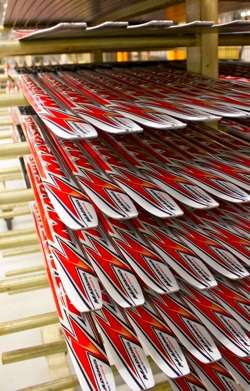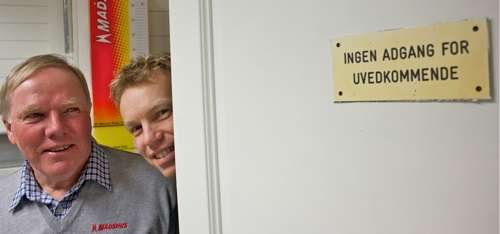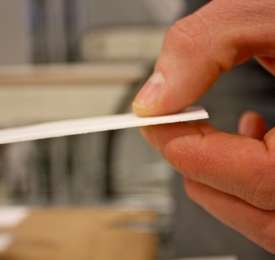On the trail of ski research

This winter, the Norwegian ski manufacturer Madshus unveiled a new pair of trailblazing skis. The innovation comes as the result of highly targeted research and development efforts.
Athletes racing on the new "Redline" skis have already captured several gold medals in just a few weeks of the 2013 winter season.
Next year the ski manufacturer, based in Biri in Oppland county, plans to offer yet another new product designed to wow ski enthusiasts and competitors alike.
"The secret behind our recent success has been our focused, long-term commitment to research and development," explains the Madshus management team.
For recreational skiers as well
From its location along the banks of the Mjøsa Lake, Madshus has secured a strong position in the market for cross-country equipment. Madshus skis are found both on the winner's podium at major championship events and on the feet of a large proportion of skiers seeking recreation and exercise on cross-country trails. The company's market share in Norway is currently close to 40 per cent; it has gained substantial ground in Sweden and is garnering serious attention on two other important markets – Finland and Russia – as well.
The fact that Norwegian elite skiers take the Madshus brand to the winner's podium gives the company an obvious boost. But even more important, however, is that the regular customers are using a product they are happy with, whether for high-intensity training or a Sunday jaunt.
"The market out there is extremely tough," explain Technical Director Gunnar Bjertnæs and Bjørn Ivar Austrem, Global Category Manager Skis.
"The competition is razor sharp and customers more demanding than ever. Today's skis are expected to be customised. Marking a ski's wax pocket and weight class is already a reality. Skis will be tailored even more to the individual user in the future."
Increased customisation
Madshus has given both competitors and customers something to think about this year. The ski manufacturer spent three years developing the new Redline skis. Underway, they set their sights on this year's World Championships as their target date.
In January, the manufacturer introduced a pair of skis weighing 10 per cent less than before. More importantly, however, the skis are much more pliable in the front and the back than before; the new Redline skis "slither" along in the ski tracks like a snake.
New technology has made it possible to fill the ski with a material that weighs no more than 100 grams. The material of choice is also used in space exploration and Formula 1 automobiles.
During the IBU Biathlon World Championships this year, many of the Norwegian participants used the Redline skis from Biri. And several members of the Norwegian national team also used the skis during the Nordic World Ski Championships in Val di Femme.
Madshus is now hard at work on an innovative new product. They are hoping the product will be ready for launch in about a year. Deep inside the factory, behind a door marked "Restricted personnel only", development efforts are underway. Neither Mr Bjertnæs nor Mr Austrem wishes to comment on what is waiting inside.
Less optimistic times too
Madshus is a manufacturing company in what may well be the most expensive country in which to produce goods. Nonetheless, business has been good in the same way that Norwegian furniture producers, car part manufacturers and many other enterprises have experienced considerable success year after year.
How do they do it?
"Customised mass production" is a key phrase at Madshus and similar enterprises. But there have been times of less optimism in Biri too. In 1996, K2 – the alpine ski manufacturer that purchased Madshus in 1988 – decided to relocate its production of alpine skis from the factory in Biri. This could have meant the end for Madshus.

At about the same time, Madshus entered into collaboration with the Norwegian University of Science and Technology (NTNU), the independent research foundation SINTEF and the Research Council of Norway. Gunnar Bjertnæs eyed the potential for adding a new dimension to the Nordic ski business.
A succession of projects under the BIA programme
As it turned out, the cooperation ended up increasing the momentum and improving the bottom line of the world's oldest ski factory.
Step by step, the products and – more importantly, perhaps, the production line – have been studied and developed. Visitors to the Madshus factory can see the progression along the production line and are thus witness to the fruits of the individual collaborative projects between the Research Council, NTNU, SINTEF and Madshus. Various projects funded under the Programme for User-driven Research-based Innovation (BIA) have led to the development of special instruments, measuring devices and hard-working robots.
Snow the biggest obstacle
"The saying goes that no two snowflakes are alike. That fact may just make snow the most difficult material we at Madshus have to work with," Mr Bjertnæs and Mr Austrem agree.
However, using mathematic models, materials researchers and the ski manufacturers have collaborated on new knowledge on how to achieve optimal glide on various types of snow. An important breakthrough occurred when they succeeded in developing a new 3D-measuring device which depicted the structure of the ski bases as three-dimensional images, thus making it possible to compare them with the snow crystals from a ski trail under a microscope.
Elite skiers on Madshus skis
When cross-country skier Thomas Alsgaard won the gold medal in the 30 km classical mass start in 2003 in Val di Femme, it proved to Madshus and the rest of the world what the company could do.
Thomas Alsgaard's victory paved the way to contracts with more elite skiers. At the same time, the company started to develop ski poles and boots to expand the Madshus brand.
The Norwegian professional biathlete, Ole Einar Bjørndalen, is another elite skier who has a long history of cooperation with Madshus. When he captured four World Championship gold medals and a World Cup Championship in 2004/2005 all using his new Madshus skis, the researchers, ski manufacturers and their owners all understood that they were on the right track towards finding the optimal correlation between snow and ski.
Research Council projects
The project "Measuring friction and structure in ski bases" was the first of a total of four Research Council-funded projects that Madhus had taken part in since 1996. Following this first project, the manufacturers in Biri staked their future on developing more advanced skis. The production of less expensive recreational cross-country skis and children's skis was subsequently moved to China.
The BIA programme funded the project "Intelligent skis – smart factories," which ran from 2006 to 2010. In 2011, the manufacturers were awarded funding under the BIA programme for a new project, "Innovative services, product expansion and personalisation in the sport industry."

For Madshus, being part of a competence network has been alpha omega. It has made it possible for the ski factory to keep pace in one of the toughest markets in the sports industry.
"A ski can in theory be seen as a wooden beam that has become highly advanced today. On-going knowledge development is needed to understand how it should be constructed. Thanks to the network we belong to, we keep on reinventing ourselves. At the same time, we are helping to build up expertise at institutions such as SINTEF and NTNU," says Gunnar Bjertnæs, looking towards his younger colleague, Bjørn Ivar Austrem, educated as an engineer at NTNU.
Mr Austrem has participated in seminars with representatives from Formula 1 as well as from the aeroplane manufacturer, Airbus, in order to understand how to construct the optimal ski.
Smart factories
The production of skis is a tiny industry on a global scale. As such, it is not possible to simply order a machine to fit the requirements of the factory floor in Biri.
"We are entirely dependent on connections with specialist environments and networks, both at home and abroad, to succeed in automating our actual production process as much as possible."
Madshus has invested in several advanced robots in recent years. The robots perform the exact instructions provided by graphic artists and engineers. They handle each and every ski very rapidly. At the end of the production line, skis are paired together in order to makes sets that are as alike as possible.
This process makes it possible for Madshus to produce between 1 000 and 1 500 different types of cross-country skis today. They produce 60 different models every day. The use of digital prototypes has dramatically reduced development time and the number of test shapes that have to be made.
The joy of innovative skiing
"Customised mass production" is a key concept among Norwegian manufacturers of goods, including Madshus.
The ski factory has a laboratory where the properties of skis are measured and adjusted based on experience in the field. Skiers such as Thomas Alsgaard, Erling Jevne and Ole Einar Bjørndalen assist Madshus by testing skis on the trails. They provide feedback on what they like about the skis as well as on what they found less than satisfactory. Combined with the advanced computer technology in use, they have helped Madshus to become world leaders in measuring the properties of skis.
Madshus hopes one day to be able to digitalise its entire production of skis. Even though they have completed much of the conversion process, Mr Bjertnæs and Mr Austrem do not deny that the transition from a traditional factory to a high-tech, mass-production factory has posed some challenges. In future, the company will need a new type of manpower as traditional labourers are being replaced by more engineers and technicians.
"For the time being, however, our long-time workers are extremely valuable due to their expertise with skis. They are willing to adapt to new tasks and we put a lot of effort into new training," states Gunnar Bjertnæs.
"We have to embrace change. At the same time, we are very aware that we need to preserve the traditional Madshus culture. Our motto is right up there," says Mr Bjertnæs, pointing up to the large poster hanging on the factory wall: "The joy of innovative skiing".
"Everything we sell is supposed to give the customer a good experience. That's what's most important."
Provided by The Research Council of Norway










.jpg)









